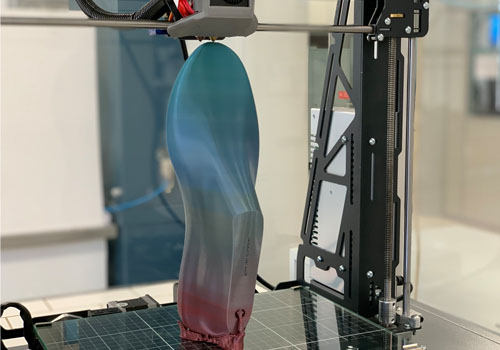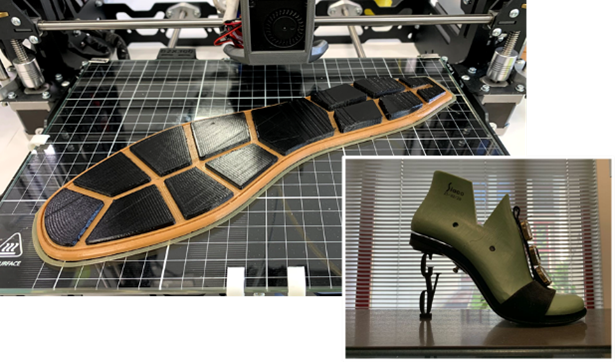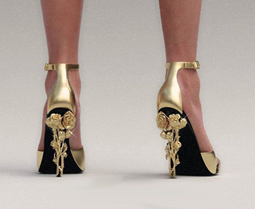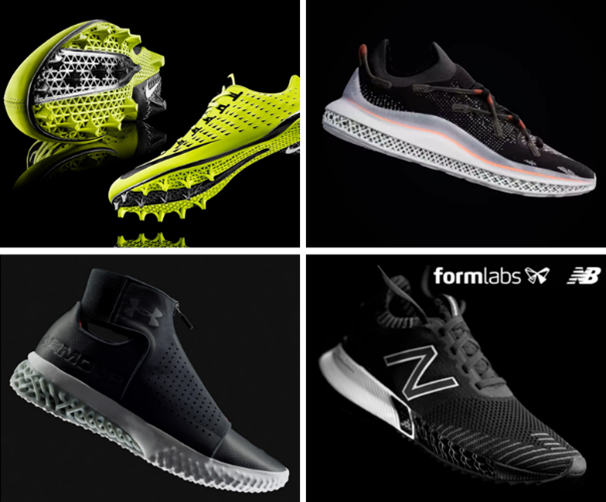DIGITAL FABLAB

Additive Manufacturing - 3D Printing
What is 3D Printing?
Additive manufacturing, commonly known as 3D Printing, is one of the Industry 4.0 pillars, which has revolutionised the productive industry world. This process allows the rapid manufacturing of three-dimensional objects, using a virtual 3D model, drawn in a computer (CAD - Computer Aided Design).
The first 3D Printing technology was developed in the 1980's with the stereolithography process, also known as SLA (Stereolithography Apparatus), in conjunction with CAD and CAM (Computer-Aided Manufacturing). The working principle of this process is based on the construction of an object in successive layers, through the curing of a photosensitive resin, using UV light. This process has allowed the rapid construction of prototypes and inserts for moulds, among other products and, thus, originating the term "rapid prototyping". This process swiftly leverages the development of new 3D printing technologies. Nowadays, it is possible to use 3D printing with ceramics, plastics, metals, composites and even with natural-based materials. This evolution has allowed the production of not only aesthetic prototypes but also functional objects, which has led to its implementation in industrial production. There are now several other 3D printing technologies, such as FFF (Fused Filament Fabrication), SLS (Selective Laser Sintering), Polyjet, Multi Jet Fusion, which are the main ones among many others.
In addition to the type of products that can be produced with 3D Printing, it is also important to highlight the impact of these technologies in sustainability. Their working principle, based on a layer-by-layer process, has a negligible waste production when compared with other processes such as CNC milling. Even when it comes to photosensitive resins processes, in which case the recycling may be particularly expensive or even impossible, most of the materials used are recyclable, as is the case of the thermoplastic polymers and metals, thus reducing the environmental impact of these technologies.
3D Printing in the Footwear Industry
The Footwear and Leather Goods industries are looking to reach the full potential of these new technologies. Currently, the main advantage of 3D printing in the industrial sector is related to the product development stage. In this process, the use of 3D printing technologies allows a significant reduction of both the time and costs of the prototype creation and in the production of components for personalised medical footwear (such as diabetic neuropathy, plantar fasciitis, flat feet, and others). In the latter case, it is possible to scan the patient's feet by integrating 3D printing with 3D scanning, using a 3D scanner, followed by 3D printing, and promptly produce either a medical insole and/or the last to assemble a medical shoe [1]. This is already a reality! This process allows to drastically reduce the time of medical footwear production, in addition to the reduction of material waste, as opposed to the traditional method. Traditionally, a shoe last is made by CNC milling, in which case a tool is used to remove material from a resin or wood block (subtractive manufacturing). The same is true for the insoles, which are typically produced by removing material from an EVA or equivalent material block to provide different flexibility zones through the insole, according to the anatomy of the patient's foot.
The Footwear and Leather Goods industries are looking to reach the full potential of these new technologies. Currently, the main advantage of 3D printing in the industrial sector is related to the product development stage. In this process, the use of 3D printing technologies allows a significant reduction of both the time and costs of the prototype creation and in the production of components for personalised medical footwear (such as diabetic neuropathy, plantar fasciitis, flat feet, and others). In the latter case, it is possible to scan the patient's feet by integrating 3D printing with 3D scanning, using a 3D scanner, followed by 3D printing, and promptly produce either a medical insole and/or the last to assemble a medical shoe [1]. This is already a reality! This process allows to drastically reduce the time of medical footwear production, in addition to the reduction of material waste, as opposed to the traditional method. Traditionally, a shoe last is made by CNC milling, in which case a tool is used to remove material from a resin or wood block (subtractive manufacturing). The same is true for the insoles, which are typically produced by removing material from an EVA or equivalent material block to provide different flexibility zones through the insole, according to the anatomy of the patient's foot.
In regards to the production of single components or entire footwear, the 3D printing has also been subject of several approaches, usually in cooperation between the footwear companies and the 3D printers' manufacturers. An example is the case of the partnership between Adidas and Carbon, which has won the "Creative Use of 3D Printing 2021" award from the prestigious 3D Printing Industry [2]. This collaboration has originated a 3D printing technology suitable for the production of soles, midsoles and even entire footwear, using photosensitive resins. Other similar examples are the collaboration between New Balance and Formlabs, and the collaboration between Nike and HP.
To reduce the time spent on product development and increase the ability to have more design iterations in a very short timeframe, PUMA switched from contracting third parties for the production of their prototypes, to in-house 3D Printing using Polyjet 3D printers. In addition to the time reduction on the product development, the use of 3D printing avoids the dependence on third parties for the prototype construction, keeping the intellectual property in-house as well. Thanks to the use of 3D printing, PUMA reached a time reduction of up to 75 % for the production of prototypes.
The Spanish footwear brand Camper also uses 3D printing to speed up the developing process of new collections [3]. Like PUMA, Camper used to hire external services to produce their prototypes, thus being dependent on third parties' time schedules, that could take several weeks. On the other hand, Camper can now produce prototypes in-house within 24 hours with 3D printing,
Recently, ECCO, in collaboration with Stratasys and Henkel Loctite, started using 3D printing to produce insert for soles injection moulds. Their main goal is to allow the designers to quickly obtain functional prototypes without the need to produce the whole mould for injection. This allows to significantly reduce the costs of processing and transportation, in addition to the time reduction of product development [4].
Recently, ECCO, in collaboration with Stratasys and Henkel Loctite, started using 3D printing to produce insert for soles injection moulds. Their main goal is to allow the designers to quickly obtain functional prototypes without the need to produce the whole mould for injection. This allows to significantly reduce the costs of processing and transportation, in addition to the time reduction of product development [4].
The foundations are, thus laid for the 3D printing technologies in the footwear industry which will become more and more of a reality: based on the pillars of sustainability and digital transformation that the sector needs and combined with the growing demand for unique products both in design and functionality. Despite this, there is still a long way to go. However, with the development of new and better technologies and materials, the future is getting closer for large and small companies, for designers and producers, for sellers and customers.
References:
[1] https://www.aetrex.com/technology.html?lang=en_US
[2] https://3dprintingindustry.com/news/2021-3d-printing-industry-awards-winners-announced-198231/
[3] https://3dprint.com/261120/camper-spanish-footwear-designed-on-3d-printers-island-mallorca/
[4] https://www.worldfootwear.com/news/ecco-bets-in-innovative-shoemaking-processes/7276.html
Pictures
[1] https://www.aetrex.com/technology.html?lang=en_US
[2] https://3dprintingindustry.com/news/2021-3d-printing-industry-awards-winners-announced-198231/
[3] https://3dprint.com/261120/camper-spanish-footwear-designed-on-3d-printers-island-mallorca/
[4] https://www.worldfootwear.com/news/ecco-bets-in-innovative-shoemaking-processes/7276.html
Pictures

Sole and heel produced through 3D Printing.
Source: CTCP
Source: CTCP

3D Printed heel.
Source: Cristina Franceschini
Source: Cristina Franceschini

Soles and midsoles produced using 3D Printing.
Source: Nike, Adidas, Under Armour e New Balance.
Source: Nike, Adidas, Under Armour e New Balance.

Process of orthopedic insoles production, using 3D Scanning and 3D Printing.
Source: Aetrex.
Source: Aetrex.
By CTCP